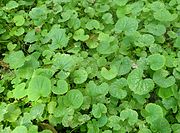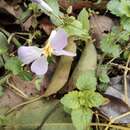Comments
provided by eFloras
An examination of the holotype of Arabis chanetii readily reveals that the name is a synonym of Orychophragmus violaceus. The former was recognized as a distinct species of Arabis in FRPS and in Fl. Hebei. (1: 538. 1986).
- license
- cc-by-nc-sa-3.0
- copyright
- Missouri Botanical Garden, 4344 Shaw Boulevard, St. Louis, MO, 63110 USA
Description
provided by eFloras
Herbs annual or biennial, (6-)15-60(-90) cm tall. Stems erect, simple or branched at base, often branched above, straight, glabrous or sparsely to densely pilose. Basal leaves not rosulate; petiole (1-)2-8(-11) cm; blade or terminal leaf lobe cordate, reniform, broadly ovate, or suborbicular, (0.4-)1.5-10(-14) × (0.3-)1-4(-7) cm, glabrous or pilose, base cordate or rarely obtuse, margin coarsely crenate with teeth ending in apiculae, apex acute or obtuse; lateral lobes 1-6 on each side, sessile or petiolulate, to 3 × 2 cm, sometimes absent. Uppermost cauline leaves auriculate or amplexicaul, sessile or petiolate, (0.5-)2-9(-15) × (0.2-)1-6(-9) cm, margin coarsely and irregularly dentate, rarely entire, apex acute or acuminate; auricles to 3 × 4 cm; lateral lobes absent or 1-4 on each side, sessile or petiolulate. Fruiting pedicels divaricate, glabrous or pilose, narrower than fruit, (0.6-)0.8-2(-3) cm. Sepals linear, erect, connivent, (0.6-)0.8-1.3(-1.6) cm × 1.5-2.5 mm, base of lateral pair strongly saccate. Petals deep purple, lavender, or white, broadly obovate, (1.2-)1.6-2.5(-3.2) cm × (4-)5-9(-11) mm, apex rounded; claw as long as sepals. Filaments 0.8-1.8 cm; anthers linear, (3-)4-6(-8) mm, distinctly apiculate. Ovules (20-)40-70 per ovary. Fruit narrowly linear, stout, terete or somewhat 4-angled, (3-)4.5-11(-13) cm × 1.5-3 mm; valves glabrous or densely hirsute, torulose, usually with a prominent midvein; style (0.3-)0.7-3(-5.5) cm; stigma slightly to distinctly 2-lobed, lobes decurrent. Seeds oblong, 2-3(-3.5) × 1-2 mm. Fl. Mar-Jun, fr. May-Jul. 2n = 24.
- license
- cc-by-nc-sa-3.0
- copyright
- Missouri Botanical Garden, 4344 Shaw Boulevard, St. Louis, MO, 63110 USA
Distribution
provided by eFloras
Anhui, Gansu, Hebei, Henan, Hubei, Hunan, Jiangsu, Jiangxi, Liaoning, Nei Mongol, Shaanxi, Shandong, Shanxi, Sichuan, Zhejiang [Korea; naturalized in Japan].
- license
- cc-by-nc-sa-3.0
- copyright
- Missouri Botanical Garden, 4344 Shaw Boulevard, St. Louis, MO, 63110 USA
Habitat
provided by eFloras
Roadsides, gardens, forests, fields, thickets, valleys, hillsides, sunny slopes; near sea level to 1500 m.
- license
- cc-by-nc-sa-3.0
- copyright
- Missouri Botanical Garden, 4344 Shaw Boulevard, St. Louis, MO, 63110 USA
Synonym
provided by eFloras
Brassica violacea Linnaeus, Sp. Pl. 2: 667. 1753; Arabis chanetii H. Léveillé; Cardamine potentillifolia H. Léveillé; Moricandia sonchifolia (Bunge) J. D. Hooker; M. sonchifolia var. homaeophylla Hance; Orychophragmus diffusus Z. M. Tan & J. M. Xu; O. hupehensis (Pampanini) Z. M. Tan & X. L. Zhang; O. sonchifolius Bunge; O. sonchifolius var. hupehensis Pampanini; O. sonchifolius var. intermedius Pampanini; O. sonchifolius var. subintegrifolius Pampanini; O. taibaiensis Z. M. Tan & B. Z. Zhao; O. violaceus var. homaeophyllus (Hance) O. E. Schulz; O. violaceus var. hupehensis (Pampanini) O. E. Schulz; O. violaceus var. intermedius (Pampanini) O. E. Schulz; O. violaceus var. lasiocarpus Migo; O. violaceus var. subintegrifolius (Pampanini) O. E. Schulz; Raphanus chanetii H. Léveillé; R. courtoisii H. Léveillé; R. violaceus (Linnaeus) Crantz.
- license
- cc-by-nc-sa-3.0
- copyright
- Missouri Botanical Garden, 4344 Shaw Boulevard, St. Louis, MO, 63110 USA
Orychophragmus violaceus: Brief Summary
provided by wikipedia EN
Orychophragmus violaceus, the Chinese violet cress, is a species of flowering plant in the family Brassicaceae. It is native to northern and southeastern China and North Korea, and it has been introduced to Japan and the U.S. state of Virginia. An annual or biennial herb typically 60 cm (24 in) tall, it is found in a wide variety of habitats, including anthropogenically disturbed ones. Hardy in USDA zones 7 through 10, in China it is cultivated as a vegetable for its stalks. The Royal Horticultural Society considers it "potentially harmful".

Flowers can be much paler

Foliage
- license
- cc-by-sa-3.0
- copyright
- Wikipedia authors and editors



